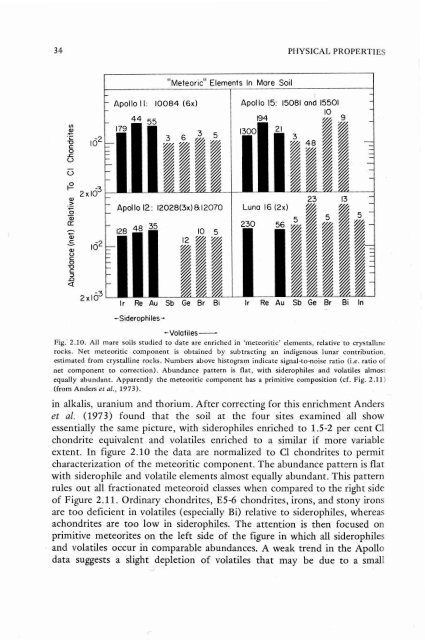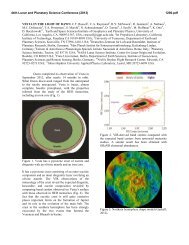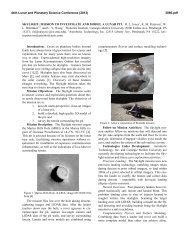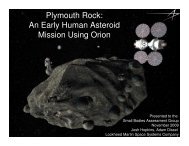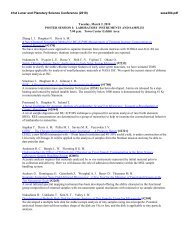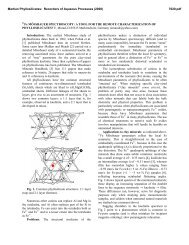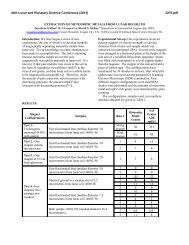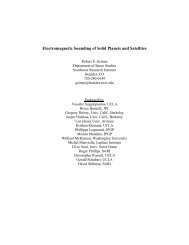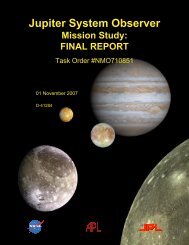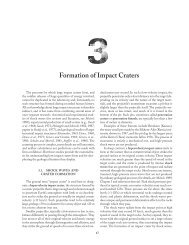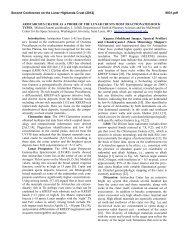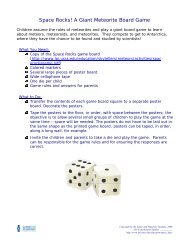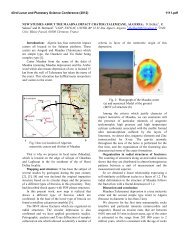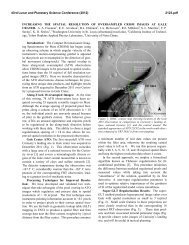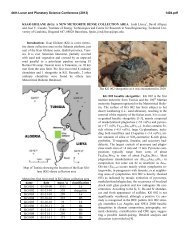Chapter 2: Energy at the Lunar Surface - Lunar and Planetary Institute
Chapter 2: Energy at the Lunar Surface - Lunar and Planetary Institute
Chapter 2: Energy at the Lunar Surface - Lunar and Planetary Institute
You also want an ePaper? Increase the reach of your titles
YUMPU automatically turns print PDFs into web optimized ePapers that Google loves.
Apol lo 12 : 12028(3x)<br />
PHYSICAL PROPERTIES<br />
I<br />
-<br />
"~eteoric" Elements In Mare Soil I<br />
-<br />
- Apol lo l I: 10084 (6x1<br />
Apollo 15: 15081 <strong>and</strong> 15501 -<br />
I<br />
Luna 16<br />
Ir Re<br />
-Vol<strong>at</strong>iles-<br />
Fig.' 2.10. All mare soils studied to d<strong>at</strong>e are enriched in 'meteoritic' elements, rel<strong>at</strong>ive to crystalline<br />
rocks. Net meteoritic component is obtained by subtracting an indigenous lunar contribution,<br />
estim<strong>at</strong>ed from crystalline rocks. Numbers above histogram indic<strong>at</strong>e signal-to-noise r<strong>at</strong>io (i.e. r<strong>at</strong>io of<br />
net component to correction). Abundance p<strong>at</strong>tern is fl<strong>at</strong>, with siderophiles <strong>and</strong> vol<strong>at</strong>iles almost<br />
equally abundant. Apparently <strong>the</strong> meteoritic component has a primitive composition (cf. Fig. 2.11)<br />
(from Anders et al., 1973).<br />
in alkalis, uranium <strong>and</strong> thorium. After correcting for this enrichment Anders<br />
et al. (1973) found th<strong>at</strong> <strong>the</strong> soil <strong>at</strong> <strong>the</strong> four sites examined all show<br />
essentially <strong>the</strong> same picture, with siderophiles enriched to 1.5-2 per cent C1<br />
chondrite equivalent <strong>and</strong> vol<strong>at</strong>iles enriched to a similar if more variable<br />
extent. In figure 2.10 <strong>the</strong> d<strong>at</strong>a are normalized to C1 chondrites to permit<br />
characteriz<strong>at</strong>ion of <strong>the</strong> meteoritic component. The abundance p<strong>at</strong>t- ~rn is fl<strong>at</strong><br />
with siderophile <strong>and</strong> vol<strong>at</strong>ile elements almost equally abundant. This p<strong>at</strong>tern<br />
rules out all fraction<strong>at</strong>ed meteoroid classes when compared to <strong>the</strong> right side<br />
of Figure 2.1 1. Ordinary chondrites, E5-6 chondrites, irons, <strong>and</strong> stony irons<br />
are too deficient in vol<strong>at</strong>iles (especially Bi) rel<strong>at</strong>ive to siderophiles, whereas<br />
achondrites are too low in siderophiles. The <strong>at</strong>tention is <strong>the</strong>n focused on<br />
primitive meteorites on <strong>the</strong> left side of <strong>the</strong> figure in which all siderophiles<br />
<strong>and</strong> vol<strong>at</strong>iles occur in comparable abundances. A weak trend in <strong>the</strong> Apollo<br />
d<strong>at</strong>a suggests a slight depletion of vol<strong>at</strong>iles th<strong>at</strong> may be due to a small


